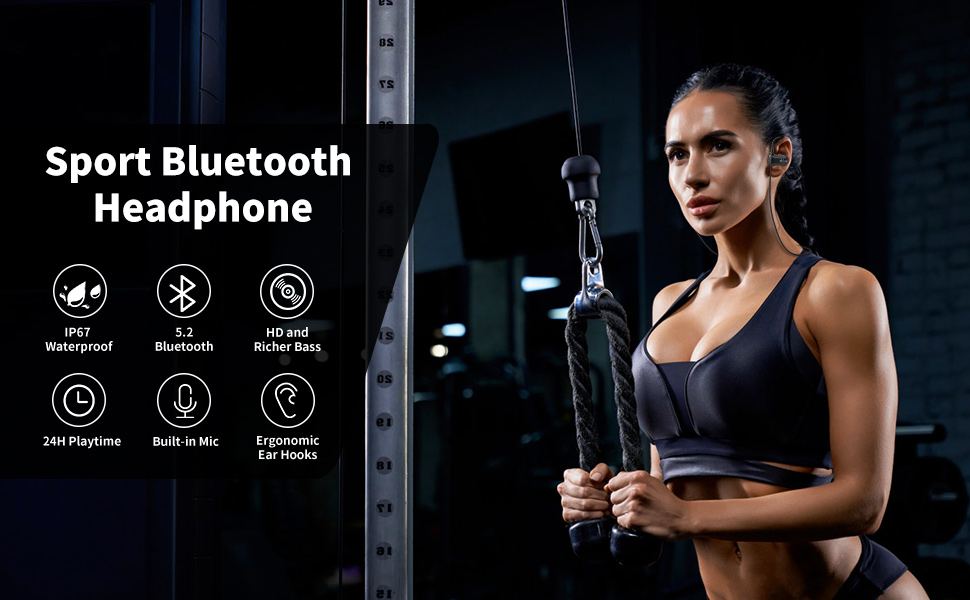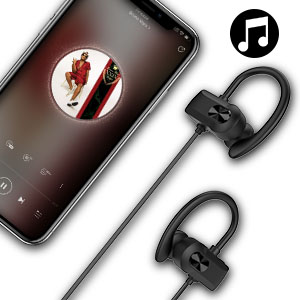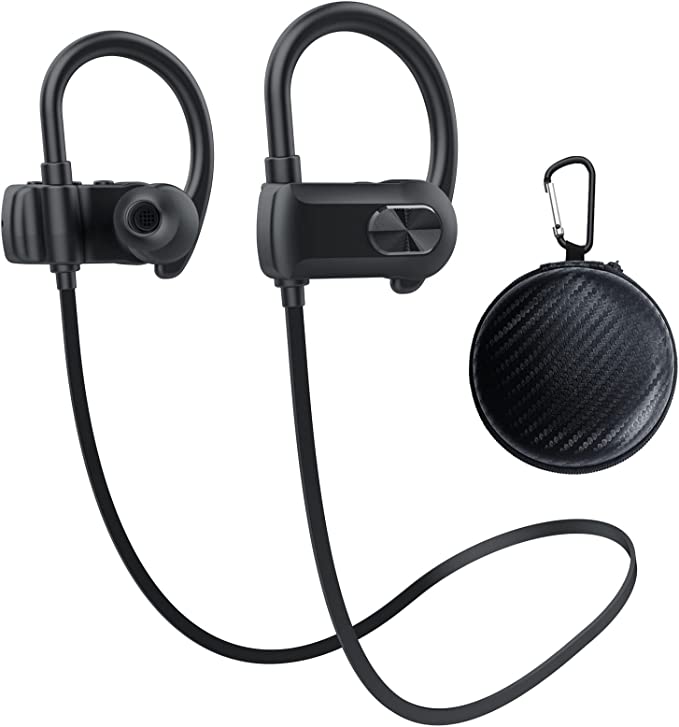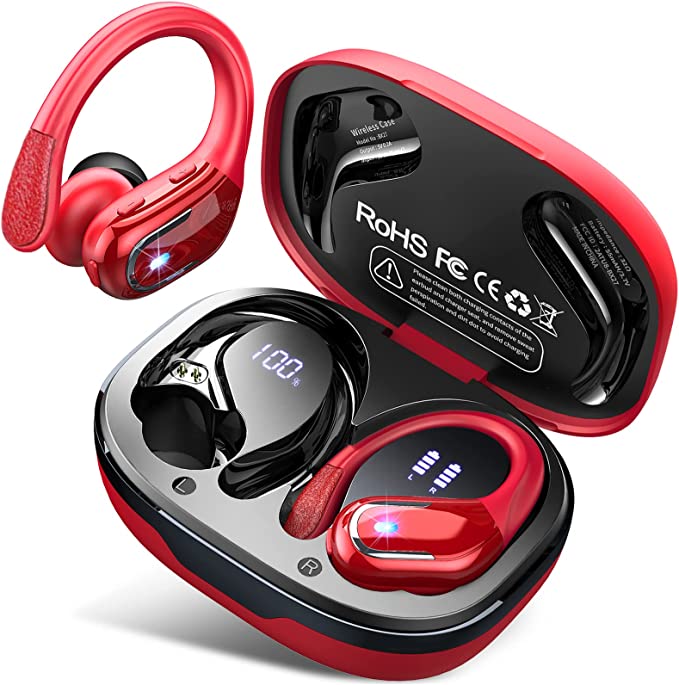The rhythm of a favorite song, the immersive world of a podcast, or the guiding voice of a workout coach – for many of us leading active lives across North America, audio is not just background noise, it’s fuel. It pushes us through that extra mile, makes the commute tolerable, and transforms a routine workout into an engaging escape. But the path to perfect workout audio is often paved with frustration: the dreaded earbud tumble mid-stride, the sudden silence of a dead battery just when you needed that power song, the crackle of a failing connection, or the discomfort of a poor fit.
Technology, however, constantly strives to smooth out these bumps. Devices like the JUSTRVN JN8D Sports Wireless Earphones represent efforts to bundle solutions to these common athlete ailments. They promise long playtime, water resistance, a secure fit, and stable connections. But beyond the marketing bullet points, what’s really going on inside these little devices? Let’s put on our metaphorical lab coats and, acting as curious tech explorers, delve into the science and engineering principles that underpin the features of earphones like the JN8D, based on its provided information, and enriched with some foundational tech knowledge.

The Heartbeat of Your Music: Demystifying the 14.2mm Dynamic Drivers
Think of the speaker driver as the vocal cords of the earphone – it’s where the electrical signal transforms into the sound waves that reach your ears. The JN8D utilizes what are called 14.2mm dynamic drivers. How do they sing? At its core, a dynamic driver works using a simple electromagnetic principle. An electrical audio signal flows through a voice coil attached to a diaphragm (a thin, flexible membrane). This coil sits within a magnetic field. As the signal changes, it creates a fluctuating magnetic force, causing the coil and the attached diaphragm to vibrate rapidly back and forth. These vibrations push and pull the air, creating the pressure waves we perceive as sound.
The size specification, 14.2mm, refers to the diameter of this diaphragm. While sound quality is incredibly complex, involving many factors beyond just size, the diameter of the driver does play a role. Generally speaking, a larger diaphragm has the potential to move more air with each vibration. This can be particularly advantageous for reproducing lower frequencies – the bass notes that provide depth and impact to music. This physical principle might be what underpins the product description’s mention of “authentic sound and powerful bass.” A well-engineered larger driver can contribute to a fuller, more robust sound profile, potentially making those workout playlists feel more energetic and immersive.

Cutting the Cord, Not the Connection: Bluetooth 5.2 Stability Explained
Wireless freedom is a key appeal of modern earphones, but it comes with its own set of challenges. Anyone who’s experienced frustrating audio dropouts knows that maintaining a stable wireless link, especially during movement or in crowded environments, isn’t always straightforward. The JN8D incorporates Bluetooth V5.2, a specific version of the ubiquitous wireless standard.
Think of Bluetooth as a sophisticated, invisible handshake between your phone (or other source device) and your earphones. Over the years, this handshake has become significantly more refined. Bluetooth 5.2 introduced several technical enhancements aimed at improving performance compared to older versions. While the full scope is complex, key goals included enhancing connection stability and potentially improving power efficiency. The product information highlights “faster connect to previously paired devices and more stable connection after power on.” In the real world, particularly for an athlete in motion, this translates to fewer jarring audio interruptions, a smoother listening experience, and less time spent fiddling with pairing. Bluetooth 5.2 represents a step forward in making that wireless handshake more reliable, even when you’re pushing your limits.
Furthermore, the source mentions the capability for one headphone set to connect with two mobile phones simultaneously. This “multipoint” functionality, often supported by later Bluetooth versions, adds a layer of practical convenience. Imagine seamlessly switching between listening to music on your personal phone and taking a work call on your business phone without having to manually disconnect and reconnect.
Powering Your Pursuits: The Science Behind 24-Hour Playtime
“Battery anxiety” is a real phenomenon, especially when relying on a device to last through a long run, a full day of travel, or back-to-back meetings. The JUSTRVN JN8D specifications claim an impressive up to 24 hours of playtime on a single charge, qualified by the condition of listening at 50% volume. How is this achieved?
The “engine” providing this endurance is almost certainly a Lithium-ion (Li-ion) battery. These batteries are favored in portable electronics due to their high energy density – meaning they can store a relatively large amount of energy in a small, lightweight package. The claimed 24-hour figure is a function of both the battery’s storage capacity (measured in milliamp-hours, though not specified in the provided text) and the power efficiency of the earphones’ components. Modern Bluetooth chipsets (like those supporting V5.2) and efficient amplifier circuits are designed to sip power frugally.
It’s crucial to understand that “up to 24 hours” is an optimistic ceiling. Real-world playtime is influenced by several factors. Listening at higher volumes requires more power, reducing battery life. Maintaining a connection in areas with heavy wireless interference can also consume more energy. Even ambient temperature can play a role in battery performance. However, a high stated maximum playtime suggests a design focus on longevity, aiming to give users confidence that the earphones won’t quit before they do.
When the battery does eventually deplete, the specifications mention a charging time of 1-2 hours (with one part of the text noting 1-1.5 hours, suggesting a typical range). This relatively quick turnaround minimizes downtime, getting you back to your audio experience swiftly.
Braving the Elements: What IP67 Waterproofing Really Means
For sports earphones, battling the elements is part of the job description. Sweat is a constant companion during intense workouts, and an unexpected downpour can interrupt an outdoor run. The JN8D addresses this with an IP67 waterproof rating. But what do those letters and numbers actually signify?
“IP” stands for Ingress Protection, and it’s part of an international standard (IEC 60529) used to classify how well an electrical enclosure resists intrusion from solids (like dust) and liquids (like water). Think of it as a standardized toughness score.
- The first digit, ‘6’, relates to protection against solids. A ‘6’ is the highest rating on this scale, meaning the enclosure is completely dust-tight. No dust particles should be able to enter under normal conditions.
- The second digit, ‘7’, deals with liquid ingress protection. A ‘7’ rating means the device is protected against the effects of temporary immersion in water. Specifically, the standard dictates it should withstand being submerged in up to 1 meter (about 3.3 feet) of freshwater for up to 30 minutes without harmful effects.
The product description also mentions a nano-coating providing further protection. These ultra-thin coatings work at a molecular level to repel liquids, adding another barrier against moisture damage.
So, what does IP67 mean practically for an athlete? It signifies robust protection against sweat, no matter how intense your workout. It means you can confidently run in the rain without worrying about damaging your earphones. It provides peace of mind against accidental splashes or even a brief drop into a puddle. However, it’s important to note what IP67 doesn’t mean. It’s not designed for prolonged submersion or swimming. It also doesn’t guarantee protection against high-pressure water jets or saltwater, which can be more corrosive. But for the typical challenges faced during land-based sports, IP67 offers a significant level of durability.
Locked In, Tuned In: Ergonomics and the Quiet of a Secure Fit
There are few things more distracting during exercise than an earbud working its way loose. Achieving a secure and comfortable fit is paramount for sports earphones, and it involves clever design based on principles of ergonomics – the science of designing things for efficient and safe human use.
The JN8D employs two key strategies mentioned in the source material. First, flexible silicone ear hooks. These hooks loop over the top and back of the ear, using the ear’s natural structure as an anchor point. This provides significant mechanical stability, counteracting the bouncing and jarring motions inherent in activities like running or jumping. Silicone is often chosen for its properties: it’s flexible enough to conform to different ear shapes, grippy enough to resist slipping (especially when slightly damp with sweat), generally comfortable against the skin for extended periods, and durable.
Second, the importance of multiple eartip sizes (three sizes are mentioned as included) cannot be overstated. Ears come in a vast array of shapes and sizes. Finding the eartip that creates a snug, complete seal within your ear canal is critical for several reasons:
1. Stability: A good seal helps hold the earbud in place.
2. Sound Quality: It ensures that the sound produced by the driver is channeled directly into your ear canal, preserving bass response and overall clarity.
3. Passive Noise Isolation: This is likely what the source refers to as “Physical Noise Cancellation.” By creating a physical barrier, a well-fitting eartip effectively blocks out a significant amount of ambient noise – the gym chatter, traffic rumble, or wind noise. This is different from Active Noise Cancellation (ANC), an electronic process using microphones to cancel external sounds, which the JN8D’s primary description doesn’t focus on (though “Active Noise Cancellation” is listed in one table field, the emphasis seems to be on the passive isolation from the fit). This passive isolation allows you to hear your audio more clearly at lower volumes and stay more immersed in your activity.
Achieving this secure, sealed fit ensures the earphones stay put, deliver sound effectively, and provide a quieter listening environment, all crucial for an optimal active audio experience. User comments included in the source text sometimes reflect satisfaction with the fit, while others might occasionally report issues, highlighting the personal nature of ear shapes and fit.

Bringing It All Together: Technology Serving Your Activity
Looking beyond individual specifications, we see how these technologies potentially synergize in the JUSTRVN JN8D. The potentially robust sound from the 14.2mm drivers aims to keep you motivated. The stability promised by Bluetooth 5.2 seeks to eliminate frustrating dropouts. The long battery life intends to remove the worry of running out of power mid-session. The IP67 rating offers durability against the sweat and rain encountered during rigorous activity. And the ergonomic ear hooks and sealing eartips work together to provide a secure, comfortable fit that enhances both stability and sound isolation.
While specifications on paper provide a starting point, understanding the underlying science and engineering principles allows for a more informed appreciation of how these features translate – or aim to translate – into tangible benefits during your workouts and daily life. It empowers you to look beyond the marketing and understand the intricate blend of physics, electronics, and material science working together right there in your ears, helping you stay connected, motivated, and immersed in your soundtrack, whatever your active pursuit may be.




